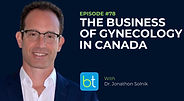BackTable / OBGYN / Podcast / Episode #34
Advanced Hysteroscopy
with Dr. Linda Bradley
In this episode, hosts Dr. Mark Hoffman and Dr. Amy Park invite Dr. Linda Bradley to discuss advanced hysteroscopy. Linda is a professor of OB/GYN and Reproductive Biology at Cleveland Clinic as well as the Director of Center for Menstrual Disorders, Fibroids, and Hysteroscopic Services.
Be part of the conversation. Put your sponsored messaging on this episode. Learn how.

BackTable, LLC (Producer). (2023, September 21). Ep. 34 – Advanced Hysteroscopy [Audio podcast]. Retrieved from https://www.backtable.com
Stay Up To Date
Follow:
Subscribe:
Sign Up:
Podcast Contributors
Dr. Linda Bradley
Dr. Linda Bradley is a professor of obstetrics, gynecology and reproductive biology with Cleveland Clinic in Ohio.
Dr. Amy Park
Dr. Amy Park is the Section Head of Female Pelvic Medicine & Reconstructive Surgery at the Cleveland Clinic, and a co-host of the BackTable OBGYN Podcast.
Dr. Mark Hoffman
Dr. Mark Hoffman is a minimally invasive gynecologic surgeon at the University of Kentucky.
Synopsis
The episode begins with Linda describing the utility of hysteroscopy: it is a great option to visualize the endocervix, endometrium, uterine healing after complicated surgeries, foreign bodies, broken IUDs, and hyperplasia. It should be used for uterine bleeding, retained products of conception, evaluating women for Asherman’s, and evaluating why the endometrium is thick on ultrasound. Hysteroscopy has two main roles: diagnosis and therapeutics. Hysteroscopic surgery allows for the uninterrupted visualization and removal of pathology, as opposed to other measures like D&C where the uterus is scraped blindly. It is also great for visually-directed, targeted biopsies and treating pathologies like fibroids and polyps. Linda emphasizes that it is a disservice to women to go in blind because fibroids or cancer can be missed with blind biopsies--in fact, pipelle biopsies picked up zero polyps in their study. Hysteroscopy surgery has a faster recovery, is less invasive, has less risks of bleeding or damaging other structures, and has low risk of infection.
The physicians then discuss techniques involving hysteroscopy. Linda prefers using a flexible hysteroscope that is 3.2 mm wide because dilation isn’t needed. She also explains that there isn’t a need for a paracervical block (just oral ibuprofen) as the patients have minimal pain when the walls of the uterus are appropriately avoided.
Linda focuses on the need to believe women when they are bleeding. It takes 3-5 doctors and 3-5 years for many women to get their bleeding appropriately treated instead of trying the same medicines without success. We have the technology to do something different, and hysteroscopy is the best option to look into the uterus and understand what is going on. Mark asks about the training of physicians in hysteroscopy, and Linda responds that simulators are key in addition to having courses and mentors to teach the technique properly. Finally, the doctors finish by talking about future applications of hysteroscopy.
Resources
Orlando, Megan S. MD; Bradley, Linda D. MD. Implementation of Office Hysteroscopy for the Evaluation and Treatment of Intrauterine Pathology. Obstetrics & Gynecology 140(3):p 499-513, September 2022. | DOI: 10.1097/AOG.0000000000004898
Transcript Preview
[Dr. Linda Bradley]
I think the important thing is this storytelling and letting women tell you their stories so you can really listen to what their bleeding is like, what's been tried, what's worked, what's not worked. We have so many stories where women are not listened to and especially for women of color. It's for everybody, but especially for women of color, the issues of bleeding. We underestimate the poor quality of life. T
Disclaimer: The Materials available on BackTable.com are for informational and educational purposes only and are not a substitute for the professional judgment of a healthcare professional in diagnosing and treating patients. The opinions expressed by participants of the BackTable Podcast belong solely to the participants, and do not necessarily reflect the views of BackTable.













